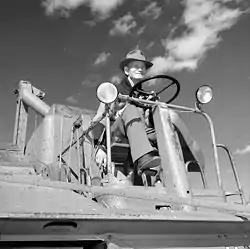James Gladstone
James Gladstone (Blackfoot: Akay-na-muka, lit. 'Many Guns'; May 21, 1887 – September 4, 1971) was a Canadian politician who became the first status Indian to be appointed to the Senate of Canada.
James Gladstone | |
|---|---|
 Senator James Gladstone sitting on his combine on the Kainai (Blood) reserve north of Cardston, Alberta (1958) | |
| Senator for Lethbridge, Alberta | |
| In office January 31, 1958 – March 31, 1971 | |
| Personal details | |
| Born | May 21, 1887 Mountain Hill, Northwest Territories, Canada |
| Died | September 4, 1971 (aged 84) Fernie, British Columbia, Canada |
| Political party | Independent Conservative |
Early life
James Gladstone's was of mixed racial ancestry, the future Blood Indigenous senator was not born a Blood and only became a status Indian at the age of 33, in 1920. His maternal grandfather, in fact, was a Scottish-Canadian, born in Montreal in 1832, who entered the service of the Hudson's Bay Company at the age of sixteen. While in the North-West Territories. William Gladstone married Harriet Leblanc, a Métis of Cree, Santee Sioux, and French Canadian heritage. One of their six children who survived to adulthood was Harriet (named after her mother), who was born at Rocky Mountain House in 1859. Harriet led a rough and unsteady life. After several years spent with a rough crowd of Métis and white frontiersmen, she formed a long-term relationship with a white lumber-mill foreman. Their union broke down, however, in the mid-1890s, and Harriet was left to raise skinny Jimmy, a boy with brown hair and blue eyes on her own. He was one of four children born to Harriet.
He attended St. Paul's Indian Residential School, because his Grandfather and local Anglican minister felt he would be fed, clothed, educated and spiritually looked after. He attended an Anglican mission school on the blood reserve, until 1903, when he moved to an Indian Industrial school (St Dunstans) in Calgary and apprenticed as a printer, interning at The Calgary Herald.[1]
Career
After leaving school in 1905, Gladstone returned to the blood reserve where he worked as an interpreter. He also found work on ranches wrangling cattle. In 1911, he found work with the Royal Northwest Mounted Police as a scout and interpreter and also worked as a mail carrier on the reserve.
He was married to Blood member Janie Healy. After his marriage he was registered a member of the Blood Reserve. Eventually, Gladstone established himself as a farmer and rancher and worked with his sons to assemble 400 head of cattle introducing modern farming practices to the reserve.
In 1949, Gladstone was elected president of the Indian Association of Alberta and was sent to Ottawa three times to press for improvements to the Indian Act. His acceptance by both Blackfoot and Cree assisted him in bringing the different groups together in one political organization.
Senate appointment
He was nominated to the Senate by Progressive Conservative Prime Minister John Diefenbaker in January 1958, two years before status Indians gained the vote in federal elections, and he pressed for Aboriginals to be enfranchised. He sat as an "independent Conservative". He advocated for integration into Canadian society. He was the chair of the Standing Committee on Indian Affairs.
Retirement and death
Gladstone retired from the Senate in March 1971 and died of a heart attack on September 4, 1971 in Fernie, British Columbia.[2]
Posthumous recognition
A biography of Senator Jim Gladstone, written by Alberta historian Hugh Dempsey, is entitled The Gentle Persuader.
In 2017, the Bank of Canada unveiled a commemorative Canadian ten-dollar note in honour of Canada 150, featuring Gladstone's portrait alongside Sir John A. Macdonald, Sir George-Étienne Cartier, and Agnes Macphail.[3]
References
- Shaw, Keith (1978). Chief mountain country : a history of Cardston and district. Volume I. Cardston: Cardston and District Historical Society. p. 99. ISBN 0-919213-89-8.
- Senator James Gladstone SICC.SK.ca
- "Canada 150 Commemorative $10 Note". www.bankofcanada.ca.
External links
- Indian Association of Alberta review of the IAA's history with attention to Gladstone's role in the organization.
- The Gentle Persuader: A Biography of James Gladstone, Indian Senator by Hugh A. Dempsey (review)
- James Gladstone – Parliament of Canada biography
| Parliament of Canada | ||
|---|---|---|
| Preceded by George Henry Ross |
Senator for Alberta 1958–1971 |
Succeeded by Bud Olson |